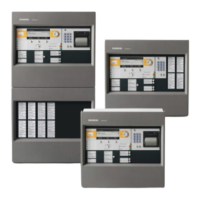23
150 | 178
23.7 Check the power supply
Check the current consumption
1. Measure the current consumption during 'Emergency power operation' and for
alarms with the highest alarm level with local and global alarms.
2. Compare the measurement values with the calculation value for emergency
current capacity.
Checking the batteries
1. Measure the battery voltage
– Min. 23 V, asymmetry max. 1 V
2. Measure the charging current.
3. Check the battery load capacity.
– The load test should only be performed if the battery charge current is
below 50 mA.
4. Disconnect the batteries from the charger.
5. Connect a conventional battery tester
1
and follow the associated operating
instructions.
1
Suitable battery testers are, for example: Celltron SCP 6/12 or Midtronics ACT V,
recommended by Powersonic, or Fluke battery tester 500 series.
Checking for power supply faults
1. Disconnect the mains supply cable.
a The following message is displayed: 'Mains failure'.
2. Disconnect the battery supply cable.
a The following message is displayed: 'Supply failure'.
Checking the mains supply cable
1. Check whether the site mains supply cable is correctly fuse-protected and
labeled (fire detection system).
2. Check whether installed overvoltage dischargers are in order.
23.8 Testing the printer
1. Check the roll of paper in the printer and ensure that there are spare rolls
available.
2. Initiate the printer test and check the print-out for legibility and correct printing.
3. Check whether the events are correctly printed out.
You will find more information about the printer in document A6V10211076. See
chapter 'Applicable documents'.
See also
2 Applicable documents [➙ 11]

